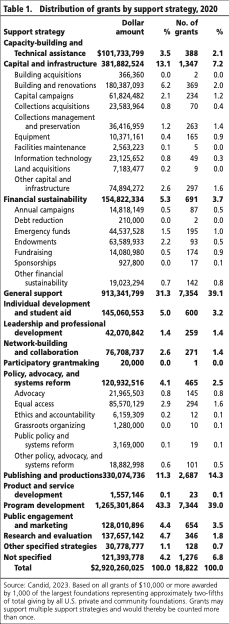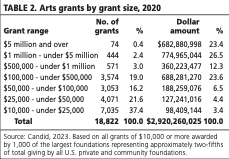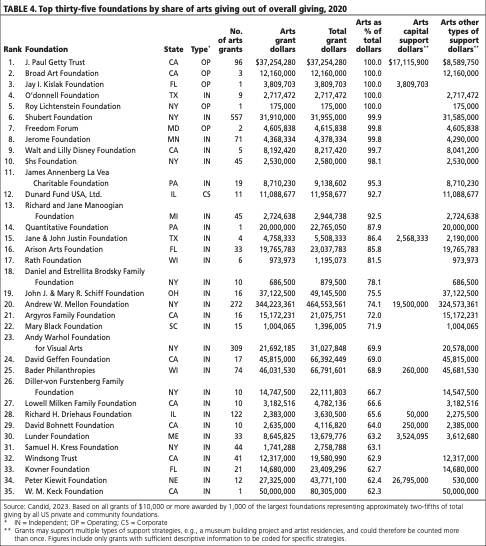Foundation Grants to Arts and Culture, 2020
A One-Year Snapshot
Steven Lawrence, Independent Consultant
A webinar reviewing this research was held on October 17, 2023. Watch now to hear Steven’s key findings and insights into what these findings reveal about the current arts grantmaking environment, as well as an introduction to what we can expect in the future.
In 2020, giving by all active U.S. private and community foundations grew approximately 16%1. Among the largest U.S. independent, corporate, community, and grantmaking operating foundations included in Candid’s 2020 Foundation 1000 dataset, overall giving rose 13% among a matched set of funders. Arts and culture funding among this matched set increased 11%, and the field continues to represent an important, albeit decreasing, priority for foundations.
Highlights
These key findings represent GIA’s twenty-first snapshot of foundation giving to arts and culture. The definition of arts and culture used for this snapshot is based on Candid’s Philanthropy Classification System and encompasses funding for the performing arts, museums, visual arts, multidisciplinary arts, humanities, historical activities, arts services, folk arts, public arts, and cultural awareness. The findings presented in this snapshot are based on an analysis of two closely related datasets. The analysis of the distribution of 2020 arts and culture giving uses the latest Foundation 1000 dataset,2 while the analysis of changes in foundation giving for the arts between 2019 and 2020 uses a matched set of foundations that are consistent between the Foundation 1000 for each of those two years.3
Foundation funding the arts held steady as a share of total dollars in 2020.
Among funders included in Candid’s Foundation 1000 dataset, giving for arts and culture totaled $2.9 billion, or 7% of overall grant dollars. This share was consistent with 2019, although notably less than the roughly 11% of foundation grant dollars that funded the arts as recently as a decade ago.
Arts funding increased in 2020 but more slowly than overall giving.
After declining in 2019, grant dollars for arts and culture awarded by a matched set of Foundation 1000 funders rose 11% in 2020. The number of arts and culture grants also increased by 3%. By comparison, during this same period overall foundation grant dollars in the set rose 13%, while the number of grants increased 20%. However, a notable share of the substantial overall increase in foundation funding, especially in terms of number of grants, reflects exceptional giving in response to the onset of the COVID-19 pandemic.
The size of the median arts grant remained consistent.
The median 2020 arts and culture grant amount of $30,000 was unchanged from 2019, and was the $40,000 median amount for foundation grants overall.4
Large grants account for more than three-fifths of arts grant dollars.
Arts grants of $500,000 or more captured 62% of overall grant dollars for arts and culture in 2020, nearly unchanged from 63% in 2019.
Relative to overall foundation giving, a larger share of arts grant dollars provide general support.
In 2020, general operating support accounted for 31% of arts and culture grant dollars. This share surpassed the 23% share of overall foundation giving that funded general operating support in that year.
Top arts funders accounted for a larger share of overall giving than in 2020.
The top twenty-five funders by giving amount provided 42% of the total arts dollars in Candid’s 2020 Foundation 1000 dataset, surpassing the 38% share in 2019. The share of arts giving accounted for by the top funders has remained relatively consistent for the past decade.
Please note: It is important to keep in mind that the foundation grantmaking examined here presents only one source of arts financing. It does not examine arts support from earned income, governments, individual donors, or the business community. This analysis also looks only at foundation arts support for nonprofit organizations, and not for individual artists, commercial arts enterprises, or informal and unincorporated activities.
Specific Findings
Overall foundation grant dollars for the arts.
The foundations included in Candid’s 2020 Foundation 1000 dataset awarded 18,822 arts and culture grants totaling $2.9 billion, or 7% of total grant dollars (figure 1). This share of grant dollars was unchanged from 2019. However, roughly a decade earlier, support for arts and culture represented close to 11% of overall foundation grant dollars.
Among a matched subset of 758 funders, grant dollars for the arts increased 11% between 2019 and 2020, compared to a 13% rise in grant dollars overall. Of the top-ranked subject areas by grant dollars, public safety showed by far the fastest growth in grant dollars—reflecting the response of the foundation community to the onset of the COVID-19 pandemic—followed by philanthropy and nonprofit management and human rights (figure 2).
The impact of exceptionally large grants.
Every year and in all funding areas, a few very large grants can skew overall totals, creating distortions in long-term grantmaking trends. In 2020, 26 arts and culture grants provided at least $10 million, and instances where these grants had a notable impact on grantmaking patterns are identified throughout this analysis. Yet, despite the potential fluctuations caused by these exceptional grants, Candid data in all fields have always included them, providing consistency over time. (In addition, Candid provides statistics based on share of number of grants, which are not skewed by exceptionally large grants.)
Community foundations represent an important source of support for arts and culture.
In 2020, community foundations provided close to one-fifth (19%) of Foundation 1000 grant dollars (figure 3) and two-fifths (40%) of the number of foundation grants for arts and culture. Actual grant dollars from community foundations totaled $542.3 million. Community foundations ranked second only to independent and family foundations by shares of grant dollars and grants and far surpassed the shares provided by corporate and grantmaking operating foundations.
Grants by Arts Subfield
Funding for the performing arts accounted for close to one-third (31%) of all foundation arts and culture dollars in 2020 (figure 4), surpassing the share reported for museums (20%). Nonetheless, from the late 1990s to the early 2000s and several times in recent years (2010, 2013, and 2014), museums surpassed the performing arts by share of grant dollars. The shifts in share between these two fields of activity from year to year have generally been due to factors such as the entry onto the scene of new and large arts funders, extraordinarily large grants, the contribution of valuable art collections, and/or new capital projects at museums.
Giving to performing arts.
Between 2019 and 2020, grant dollars for the performing arts increased 3% among a matched set of funders, while the number of grants declined 1%. A total of 7,469 grants were awarded for the performing arts by foundations in the set—two and one-half times the number awarded for museums. In general, the median performing arts grant tends to be smaller in size than the median museum grant ($28,500 versus $35,000 in 2020). The largest share of giving to the performing arts supported theaters and performing arts centers. Among the largest performing arts grants in the latest sample was a $12.9 million grant from the Community Foundation of Greater Greensboro to McLaren Oakland for a performing arts center. Included within the performing arts is support for performing arts education, which totaled $111.1 million in 2020. (See “Giving to multidisciplinary arts” below for a figure on foundation grant dollars supporting other types of arts education.)
Giving to museums.
In 2020, museums benefited from 2,991 grants totaling $909.8 million awarded by funders included in the Foundation 1000 dataset. More than half of this funding supported art museums. Among a matched set of funders, both grant dollars and the number of grants allocated to museums declined 4% between 2019 and 2020. The largest museum grant in 2020 was a $50 million award from the W.M. Keck Foundation to the Los Angeles County Museum of Art to improve access to art and art education for people in the region.
Giving to multidisciplinary arts.
The share of arts giving for multidisciplinary arts increased to 17% in 2020 from 12% in 2019.5 Among a matched set of funders, grant dollars for multidisciplinary arts increased by nearly half (48%), while the number of grants rose 6%. Within multidisciplinary arts, general services to arts organizations, including facilities or touring assistance, accounts for more than half of funding. Of the various subcategories of multidisciplinary arts, arts education (excluding performing arts education) totaled $166.1 million in 2020.
Giving to humanities.
The humanities benefited from 1,705 grants totaling $364.2 million in 2020 from funders included in the Foundation 1000 dataset.6 Funding for this area accounted for 12% of arts grant dollars in 2020, down slightly from 13% in 2019. However, among a matched set of funders, grant dollars awarded for the humanities increased 20%, while the number of grants rose 1%.
Giving to visual arts.
The visual arts and architecture benefited from $238.1 million in 2020 from Foundation 1000 funders. Among a matched set of funders, grant dollars for the visual arts increased 8% between 2019 and 2020, while the number of grants rose 3%. The largest grant reported was a $40 million award from Bader Philanthropies to Queens University at Kingston in Canada to support the creation of a new state of the art home for the Agnes, which will be a premiere center for education and research in the visual arts.
Giving to historical activities.
Grant dollars for historical activities declined 24% among a matched set of funders between 2019 and 2020, and the number of grants decreased 22%.7 Overall, historical activities benefited from 1,121 grants totaling $163.8 million in 2020.Grants by Support Strategy
An important caveat to report with regard to the allocation of foundation dollars by specific support strategy is that for about 4% of arts grant dollars in the 2020 Candid sample, the support strategy could not be identified. This means that modest differences in percentages may not be reliable. (The grant records available to Candid may lack the information necessary to identify the support strategy, especially if the source of data is the 990-PF tax return, which tends to be less complete than other forms of grant reporting.)
Table 1 provides a breakdown of specific support strategies within the larger support categories and lists both the specific dollar value and number of grants made in each type. However, it is important to keep in mind that this table includes only grants of $10,000 or more awarded to organizations by a sample of 1,000 of the largest U.S. foundation by total giving.
The arts compared to other fields of foundation giving.
The three largest categories of support tracked by Candid are program support, general operating support, and capital support.
Program support accounted for the largest share of arts grant dollars in 2020 (43% of all arts funding). Special programs and projects typically receive one of the largest shares of arts and culture grant dollars and grants. The same is true in most of the major fields, such as health and education, where program support consistently accounts for one of the largest shares of funding.
General operating support accounted for the second largest share of arts grant dollars in 2020 (31% of all arts funding). The shares of grant dollars and number of grants allocated for this support strategy in 2020 were higher for arts and culture (31% and 39%, respectively) than the overall share directed to general operating support by the Foundation 1000 funders, which accounted for 23% of grant dollars and 35% of the number of grants.
Capital support accounted for the third largest share of arts grant dollars. Similar to general support, the share of grant dollars allocated for this type of support was also higher for arts and culture (13%) than for grants overall (6%). Grants for capital support are larger on average than awards for program and general operating support, and exceptionally large capital grants can have a pronounced effect on the distribution of funding by support strategy.
Grants by Grant Size.
Median grant size.
The median or “typical” grant amount for arts and culture in 2020 was $30,000, which fell below the median amount for all foundation grants ($40,000). This is the sixth consecutive year that the median arts grant amount has exceeded $25,000.8
Small and midsized grants.
Approximately three-fifths (59%) of all arts grants in the 2020 sample were for amounts between $10,000 and $49,999 (table 2), consistent with the 2019 share. The share of midsized arts grants ($50,000 to $499,999) also remained consistent, accounting for just over one-third (35%) of arts grants.
Large grants.
The share of larger grants ($500,000 and over) remained consistent at roughly 6% of the total number of grants in 2020. Their share of total grant dollars also accounted for a largely consistent 62%. Overall, foundations in the sample made 74 grants of $5 million and over in 2020, up from 52 grants in 2019.
In addition to the $50 million award from the W.M. Keck Foundation to the Los Angeles County Museum of Art and $40 million grant from Bader Philanthropies to Queens University at Kingston noted earlier, examples of other especially large grants in 2020 include a $20 million grant from the Peter Kiewitt Foundation to Omaha Discovery Trust to provide capital support for the construction of the Kiewit Discovery Center; and a $10 million grant from the JPB Foundation to Community Funds for the NYC COVID-19 Response & Impact Fund, which provided critical funding to help bridge the gap for human service and arts and culture nonprofits that lost crucial revenue.
The twenty-five largest arts funders.
The top twenty-five arts and culture funders by giving amount provided 42% of the total arts dollars in Candid’s 2020 sample (table 3), surpassing the 38% share in 2019. Overall, the share of giving accounted for by the top twenty-five arts funders has fluctuated between roughly 30% and 40% since the end of the 1990s.
Top foundations by share of arts giving out of overall giving.
Among funders included in the Foundation 1000 that committed high percentages of their grant dollars to arts and culture, many were smaller (table 4). Of the top one hundred foundations ranked by share of arts giving out of overall giving, over half (57 funders) gave less than $5 million in total arts grant dollars in 2020.
Giving for International Cultural Exchange.
Grant dollars supporting international culture exchange were up 5% between 2019 and 2020 among a matched subset of funders. Although, the number of grants they awarded declined by one-third (34%). In 2020, foundations awarded 64 grants related to international cultural exchange totaling $8.5 million. Among the larger awards was a $1.1 million general support grant from the Foundation to Promote Open Society to the Amsterdam-based Prince Claus Fund for Culture and Development, which connects artists and cultural practitioners in Africa, Asia, Latin America, the Caribbean, and Eastern Europe, especially where cultural expression is under pressure.
ABOUT THE AUTHOR
Steven Lawrence is an independent consultant who partners with foundations and philanthropy-serving organizations to document critical trends in the field. Among many reports he has authored in collaboration with GIA are Arts Funding at Twenty-Five: What Data and Analysis Continue to Tell Funders About the Field and Recalculating the Formula for Success: Public Arts Funders and United Arts Funds Reshape Strategies for the Twenty-First Century.




